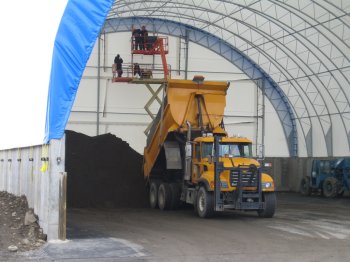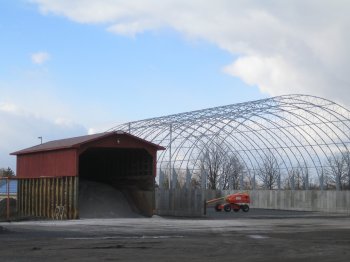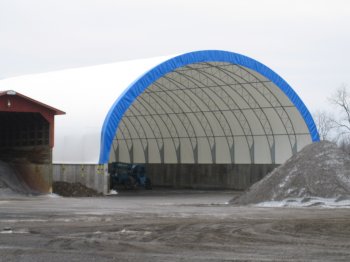- By Dan Veaner
- Around Town
 Print
Print
Lansing Highway Department's new salt and sand storage building is up and running after months of planning, engineering and building. Looking like a cross between a gigantic Quonset hut and a tent, the new structure towers over the old salt storage building. With more than 14 times the storage capacity, the new building will hold all 4000 tons of sand needed for a winter season, and enough salt to take care of at least three snow storms. "It's quite a building," says Highway Superintendent Jack French. "It's going to help us tremendously."
French estimates the building will cost $180,000 when all the bills are counted. But this is less than it could have cost. French estimates his crew saved the town $25,000 to $30,000 by doing the work of laying the concrete slab and walls themselves. "Most highways don't have the talent," he says. "That's a big job. They took pride in it and enjoyed doing it, and they know they're going to get a huge benefit out of it."

The first loads of sand went into Lansing's new salt and sand
storage building Tuesday as workers used a cherrypicker to
finish fastening the fabric skin to the building
Additionally Town Planner Darby Kiley has applied for a federal grant that could pay for 90% of the project. One of the qualifications is intermunicipal use, which French is optimistic Lansing meets, because his department plows Village of Lansing and County roads on contract. Town officials expect to learn whether Lansing gets the grant this Spring.
French says that the Town uses an average of 4,000 tons of sand and the same of salt per winter season. With the old storage building holding only 350 tons, salt and sand has been piled outside to make sure there has been enough. But rain and cold weather disperse the materials, as well as freezing it into unworkable clumps. Highway department workers have had to climb onto their trucks to try to kick icy clumps apart so they won't clog spreaders.

The old salt storage building (right) holds 350 tons, to the new building's
5000 ton capacity. That's more than 14 times the old building's capacity.
"It's going to be easier for our drivers as far as getting the material down on the roads," explains French. "It's going to be a lot better product going on the roads. It's not going to be diluted, it's not going to be frozen. It's pretty dangerous -- a lot of guys go up on top of the spreaders and kick chunks off in the middle of the night when the wind's blowing 30 or 40 miles per hour. They shouldn't have to do much of that any more."
The larger capacity will also save workers having to haul salt and sand during storms. The Town gets its sand from a supplier in Groton, and its salt from Cargill. French says they probably would have gotten a larger building that could hold an entire winter's salt as well as sand, but with the salt mine right in town it isn't necessary. Lansing trucks can pick up salt from Cargill as late as 10 pm. That works out well, because the department's trucks hold about 18 to 19 tons of salt. That means to 210 to 222 trips to Cargill to get a year's worth of salt, and the same again to Groton to get the sand.
Everyone on the 14 man crew worked on the building, but four or five did the bulk of the construction. Scott Weaver led the initiative. "He took the bull by the horns and really did a nice job," French says. "I can't say enough about how they did it. They just did a great job."
Accu-Steel, an Iowa company, won the bid to provide the building, then Town Engineer David Herrick engineered the foundation and walls. Steel arches rise from the concrete walls, and fabric is stretched over them. French says that the steel is guaranteed for 25 years and the fabric for 15, but with care they can be made to last longer. He plans to wash the building and apply anti-corrosive material to it each Spring.

"My guys have never done anything like that before, but some of them said, 'Yeah, we can do it,'" French relates. "They worked in all sorts of weather -- cold, rain -- really terrible weather sometimes. They never complained, and they actually enjoyed doing it. The guys that worked on it were pretty proud of what they did, and they did a great job of building the foundation and the wall, which is the hardest part."
While this is the second Accu-Steel building in the Central New York area, the company has been providing these buildings in the midwest for years. French says the company is trying to gain a foothold in the Central New York market, and that may account for their winning the bid. Herrick checked the company out before the Town accepted the bid.
French notes that the Department of Environmental Conservation (DEC) has predicted that New York State will mandate storing salt inside a building in the future. "A lot of highway departments have had them for quite a few years, and more and more are getting them every year," he notes. "I know of at least ten within 50 miles of us that are getting sand and salt storage buildings."
Town workers began dumping loads of sand into the building Tuesday as Accu-Steel workers finished attaching the fabric cover. French was most proud of his crew and the initiative they took in tackling a difficult project and saving the Town money. "We've got a pretty diverse group of carpenters and masons and farmers -- they do jobs that a lot of highway departments don't," he says. "They always have. In the middle of the winter they're going to enjoy the product they're putting out instead of having to get out and clean a chunk out of the back and that kind of thing."
----
v2i48
French estimates the building will cost $180,000 when all the bills are counted. But this is less than it could have cost. French estimates his crew saved the town $25,000 to $30,000 by doing the work of laying the concrete slab and walls themselves. "Most highways don't have the talent," he says. "That's a big job. They took pride in it and enjoyed doing it, and they know they're going to get a huge benefit out of it."

The first loads of sand went into Lansing's new salt and sand
storage building Tuesday as workers used a cherrypicker to
finish fastening the fabric skin to the building
Additionally Town Planner Darby Kiley has applied for a federal grant that could pay for 90% of the project. One of the qualifications is intermunicipal use, which French is optimistic Lansing meets, because his department plows Village of Lansing and County roads on contract. Town officials expect to learn whether Lansing gets the grant this Spring.
French says that the Town uses an average of 4,000 tons of sand and the same of salt per winter season. With the old storage building holding only 350 tons, salt and sand has been piled outside to make sure there has been enough. But rain and cold weather disperse the materials, as well as freezing it into unworkable clumps. Highway department workers have had to climb onto their trucks to try to kick icy clumps apart so they won't clog spreaders.

The old salt storage building (right) holds 350 tons, to the new building's
5000 ton capacity. That's more than 14 times the old building's capacity.
"It's going to be easier for our drivers as far as getting the material down on the roads," explains French. "It's going to be a lot better product going on the roads. It's not going to be diluted, it's not going to be frozen. It's pretty dangerous -- a lot of guys go up on top of the spreaders and kick chunks off in the middle of the night when the wind's blowing 30 or 40 miles per hour. They shouldn't have to do much of that any more."
The larger capacity will also save workers having to haul salt and sand during storms. The Town gets its sand from a supplier in Groton, and its salt from Cargill. French says they probably would have gotten a larger building that could hold an entire winter's salt as well as sand, but with the salt mine right in town it isn't necessary. Lansing trucks can pick up salt from Cargill as late as 10 pm. That works out well, because the department's trucks hold about 18 to 19 tons of salt. That means to 210 to 222 trips to Cargill to get a year's worth of salt, and the same again to Groton to get the sand.
Everyone on the 14 man crew worked on the building, but four or five did the bulk of the construction. Scott Weaver led the initiative. "He took the bull by the horns and really did a nice job," French says. "I can't say enough about how they did it. They just did a great job."
Accu-Steel, an Iowa company, won the bid to provide the building, then Town Engineer David Herrick engineered the foundation and walls. Steel arches rise from the concrete walls, and fabric is stretched over them. French says that the steel is guaranteed for 25 years and the fabric for 15, but with care they can be made to last longer. He plans to wash the building and apply anti-corrosive material to it each Spring.

"My guys have never done anything like that before, but some of them said, 'Yeah, we can do it,'" French relates. "They worked in all sorts of weather -- cold, rain -- really terrible weather sometimes. They never complained, and they actually enjoyed doing it. The guys that worked on it were pretty proud of what they did, and they did a great job of building the foundation and the wall, which is the hardest part."
While this is the second Accu-Steel building in the Central New York area, the company has been providing these buildings in the midwest for years. French says the company is trying to gain a foothold in the Central New York market, and that may account for their winning the bid. Herrick checked the company out before the Town accepted the bid.
French notes that the Department of Environmental Conservation (DEC) has predicted that New York State will mandate storing salt inside a building in the future. "A lot of highway departments have had them for quite a few years, and more and more are getting them every year," he notes. "I know of at least ten within 50 miles of us that are getting sand and salt storage buildings."
Town workers began dumping loads of sand into the building Tuesday as Accu-Steel workers finished attaching the fabric cover. French was most proud of his crew and the initiative they took in tackling a difficult project and saving the Town money. "We've got a pretty diverse group of carpenters and masons and farmers -- they do jobs that a lot of highway departments don't," he says. "They always have. In the middle of the winter they're going to enjoy the product they're putting out instead of having to get out and clean a chunk out of the back and that kind of thing."
----
v2i48



